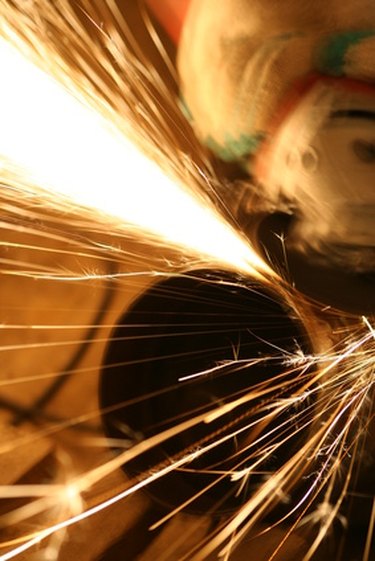Things You'll Need
15-by-2-by-0.5-inch steel bar
Cardboard
Power jigsaw
Belt grinder
120-, 250- grit grinding belts
Furnace
Vegetable oil
400-grit sandpaper
Eye protection
Wood
Fabric or leather
Glue

A fleshing knife is a type of knife used to remove the remaining bits of flesh and fat off the back of a piece of animal hide. It has two handles, one on either end of the blade. The blade must be thin, and ideally it should be slightly curved to produce the most effective fleshing knife. Fleshing knives are quite easy to make, even for the novice bladesmith, but you must take your time during the production process or you may end up with an ineffective blade. The fleshing knife described here is made by the stock removal method, although you can also forge the blade to the desired shape if you wish.
Step 1
Design the knife. It is very important that you design the blade before you start making it. It is a good idea to cut the design out of cardboard so that you are comfortable with the overall feel and handling. Keep in mind that when designing a fleshing knife you must have two four-inch tangs, one on either end of the blade. The tang is the end of the knife that protrudes from the blade and will eventually become the handle.
Video of the Day
Step 2
Cut the blade shape out of steel. In order to do this you will need to draw the shape of the blade onto a 15-by-2-by-0.5-inch piece of high carbon steel. 1905 steel is ideal for a fleshing knife, but you can also use other types such as stainless steel. The tangs should be at least four inches in length. Using a power jigsaw, carefully cut the knife profile out of the steel.
Step 3
Grind the blade. Using a belt grinder, grind the edge of the knife at a 20-degree angle. Use a 120-grit belt. The most important thing to remember when doing this is that you should only grind the edge bevel on one side of the blade. This way, the flat side of the blade will shave the animal hide closer and more consistently than if you grind both sides.
Step 4
Heat treat the blade. Heat the blade in a furnace until it is a dull orange color all over. When it has reached this heat, submerge the blade in a bath of oil. You can use vegetable oil for this.
Now temper the blade. Heat the blade in the furnace to around 350 degrees F, or until it has a blue sheen, and dunk it in the oil bath. Repeat the tempering procedure three times to make sure the blade has fully tempered.
Step 5
Attach the handles. Simply glue two identically shaped pieces of wood to either side of the tang and wrap them in leather or fabric to hold them in place. You could also just wrap fabric around the tangs, as long as the knife is comfortable to hold.
Step 6
Sharpen the blade using the belt grinder and a 250-grit belt. Run the blade edge along the belt and sharpen to your liking. Make sure the blade does not overheat while sharpening it or the temper will be knocked out. A good rule of thumb is that if the blade is too hot to touch, then it's too hot.
Tip
Remember that while fleshing knives can have a straight edge, the knife will have a greater cutting power if it is slightly curved.
Warning
Wear eye protection whenever you grind, as the metal shards can be extremely harmful.
Video of the Day